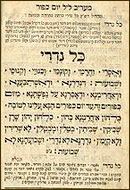All These Vows

The language of Kol Nidrei, chanted in Jewish congregations just before Yom Kippur, is complex, obscure, and legalistic. Yet it continues to fascinate. Rabbi Lawrence A. Hoffman, professor of liturgy at Hebrew Union College-Jewish Institute of Religion, has edited a new collection of essays titled All These Vows: Kol Nidre. Those who want to prepare for Yom Kippur by understanding the reasons for the lasting fascination with Kol Nidrei should read the first half of this book—but may want to stop before the second half.
No one knows for sure how Kol Nidrei originated. It is by far the best-known Yom Kippur prayer, but in fact it is neither a prayer nor actually recited on Yom Kippur. Rabbis have never liked it. In the early Middle Ages, some of them sought to exclude it from the liturgy altogether. Others, a few centuries later in France, changed the wording to render it more palatable. Still others, in 19th-century Central Europe, excised even the newer version from the liturgy. Yet its melody evokes Jewish associations so intimate that even many who are otherwise completely estranged attend synagogue to listen. The tune was appropriated by Beethoven and popularized by Perry Como and Johnny Mathis. Al Jolson sang it at the emotional climax of the film The Jazz Singer, the first full-length talkie, in 1927.
One of the great mysteries of Jewish liturgy is how Kol Nidrei achieved its exalted role on Yom Kippur eve, the holiest day of the Jewish year. The text, devoid of emotional resonance, is a technical legal formula that nullifies vows. Since halakhah prohibits nullification on Sabbaths and holidays, Kol Nidrei is recited before the onset of Yom Kippur. In its original form, still used in the Sephardic rite, it refers to all vows taken over the course of the previous year. The formula does not actually conform to talmudic requirements for nullification: For one thing, there is no mention of any specific vow that needs undoing. Therefore, rabbis in the 9th and 10th centuries discouraged its recitation. But rabbinic opposition could not overcome what, by then, had apparently become a deeply-rooted folk practice. In the early 12th century, Rabbi Jacob Tam, grandson of the great talmudist Rashi, sought to ameliorate halakhic objections by changing the wording so that it referred not to vows already made but to those that would be taken in the coming year. This became the predominant version among Ashkenazim.
In Jewish law, the nullification of vows does not apply to obligations undertaken toward one's fellow man. Nevertheless, anti-Semites had a field day with Kol Nidrei, because the prayer's formula reinforced the notion that Jews were authorized by their religion to renege on promises and that they could not be trusted. As a result, medieval European tribunals demanded that Jews take an especially humiliating oath, designed to counteract what was understood as Kol Nidrei's dispensation to break their word. With the emancipation of European Jewry that began in the late 18th century, and the possibility of acceptance as equal citizens, Kol Nidrei was seen as an embarrassment. The Reform movement went so far as to eliminate the prayer from its liturgy in 1844.
Yet it is a safe bet that anyone attending services this Yom Kippur eve, which occurs tonight, Friday, October 7, will hear Kol Nidrei sung in the traditional melody before a hushed congregation.
The contributors to Hoffman's volume analyze Kol Nidrei from the perspectives of halakhah, history, anthropology, and psychology, while also providing the Aramaic text along with a word-by-word explanation. Among the outstanding essays is one suggesting that the formulations of Kol Nidrei had their origin in ancient Babylonian superstition. Two essays trace the attempt by Reform Judaism to rid itself entirely of Kol Nidrei, the failure of this attempt because of wide-scale sentimental attachment to the prayer, and its ultimate restoration in the movement's 1978 mahzor, Gates of Repentance. There is a sensitive account of how and why the claim that Kol Nidrei originated as a way for Spanish Marranos to annul their forced acceptance of Christianity—a totally fictitious story—found its way into history books, sermons, and Jewish popular culture.
The book's second half, titled "Interpretations for Today," is considerably weaker. It consists of 24 short personal reactions to Kol Nidrei. In the spirit of gender-correctness, 14 of them are by women. Though much of the power of the Kol Nidrei text lies precisely in its strange, even alienating legalism and utter unsentimentality, many of these pieces find in Kol Nidrei safe truisms that the writer—lo and behold!—already espoused. One contributor, an "avid meditator," sees Kol Nidrei as promoting meditation. A social activist believes that it calls for anti-AIDS programs. There is even a Los Angeles rabbi who compares it to a Dodgers game, as well as a colleague in New York who sees in it Alice in Wonderland. Such is what passes for "spirituality" today.
Going through the book before Yom Kippur will make the reader an "educated consumer" when Kol Nidrei is chanted but will not solve the mystery of this liturgy's ongoing attraction. To what extent is it the ancient Ashkenazic tune, which pulls at the heartstrings; nostalgia for the Yom Kippur remembered from childhood, when family and friends, now gone, made us feel protected and secure; being brought up short by lingering guilt for words we regret saying; or, seeing everyone dressed in white—the color of shrouds—confronting the certainty that death awaits us and we have not yet fulfilled our obligations?
Lawrence Grossman is the director of publications at the American Jewish Committee.
I cannot make any sense of this throwaway line. Are we to understand that this is part of the reason why the section is "weak?" Is the fact of female contribution really so remarkable that it can only be explained (and disparaged) with reference to the editors' "gender correctness"?
Comments are closed for this article.




